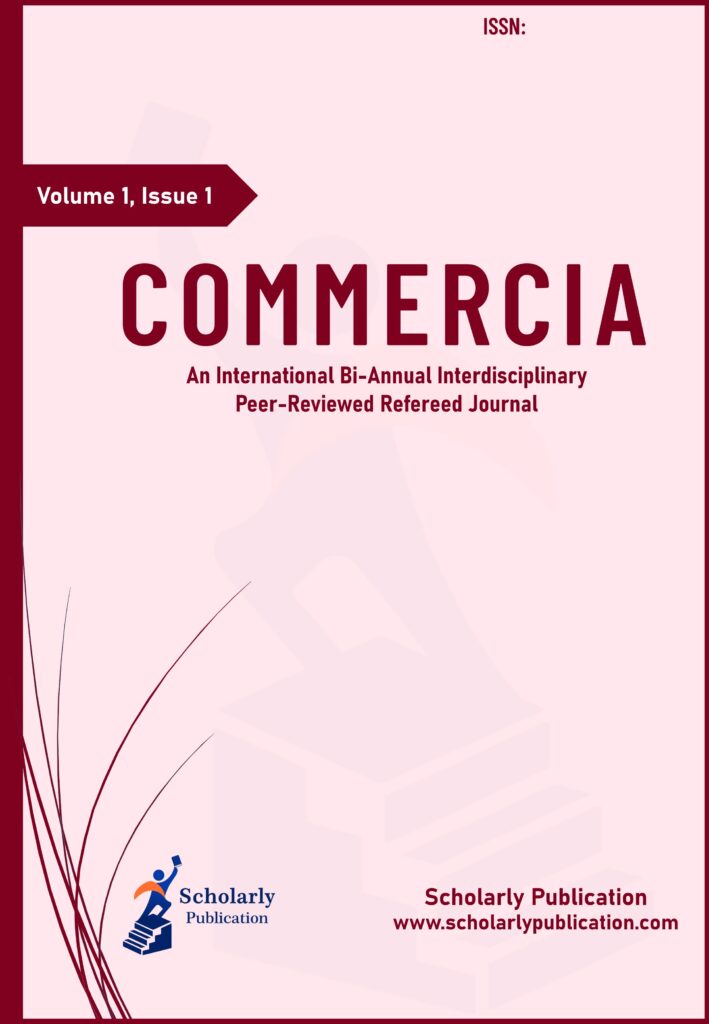An Analysis to Evaluate and Quantify Investment Flows Between India and Sri Lanka Following the Implementation of the ISFTA
Volume 1, Issue 2, Article Number: 252002 (2025)
Home >> Commercia >> Volume 1, Issue 2
a Assistant Professor, University School of Applied Management, Punjabi University Patiala, Punjab-147002 (India)
*Corresponding Author: devprakash26@gmail.com
Received: 16 August 2025 | Revised: 24 August 2025
Accepted: 25 August 2025 | Published Online: 27 August 2025
DOI: https://doi.org/10.5281/zenodo.16903663
© 2025 The Authors, under a Creative Commons license, Published by Scholarly Publication
Abstract
This study evaluates the consequences of the India-Sri Lanka Free Trade Agreement (ISFTA) on foreign direct investment (FDI) flows between India and Sri Lanka during the period of 2006-2024 with some comparisons towards the increasing impact of China. The study investigates whether the ISFTA has stimulated sustained Indian FDI growth, what is its comparative role to China, and whether the agreement contributed to long-term bilateral investment. It employed a mixed-methods perspective involving a quantitative aspect (CAGR, trend analysis, percentage share based on BOI Sri Lanka, RBI, Central Bank of Sri Lanka data) and a qualitative review of the policy framework, agreements and investment reports. The results suggest some considerable increases in Indian FDI since 2006, which peaked at US$341 million in 2018 but fluctuated significantly. Conversely, it suggests that there was significant expansion within Chinese FDI from 2012 onwards and has consistently surpassed Indian investment levels. In 2022, 34% of Sri Lanka FDI inflows were Chinese. Overall, ISFTA made a positive contribution to strengthen investment relations between India and Sri Lanka, however its impact on supporting ongoing competitiveness of investment in the long-term – in relation to China’s emergence – has been modest. The study concludes that although India has considerable unutilised potential in certain sectors, like information technology, tea etc., there is an urgent need for strengthened policy support and investment strategies for India’s deeper involvement in the economic development of Sri Lanka.
Keywords
ISFTA, FDI, Bilateral Trade Interactions, Policy Framework, Investment Strategies
References
References
Akram, H. W., Ahmad, A., Dana, L. P., Khan, A., & Akhtar, S. (2024). Do Trade Agreements Enhance Bilateral Trade? Focus on India and Sri Lanka. Sustainability, 16, 582.
[View Article] [Google Scholar]
Alam, M. S., & Zubayer, M. (2010). Intra regional foreign direct investment (FDI) prospect in South Asian Association of Regional Cooperation (SAARC) region. International Journal of Economics and Finance, 2, 114-121.
Athukorala, P. P. A. W. (2003). The impact of foreign direct investment for economic growth: A case study in Sri Lanka. In 9th International Conference on Sri Lanka Studies, 92, 1-21.
Chinagorom-Abiakalam, D., & Leibovici, F. (2025). Nontariff Trade Barriers in the US and EU. Federal Reserve Bank of St. Louis.
Fernando, S. N. (2010). China’s relations with Sri Lanka and the Maldives: Models of good relations among big and small countries. China Report, 46, 285-297.
[View Article] [Google Scholar]
Iqbal, B. A., Rahman, M. N., & Yusuf, N. (2018). Determinants of FDI in India and Sri Lanka. Foreign Trade Review, 53, 116-123.
[View Article] [Google Scholar]
Joshi, V., Pitke, M., Baral, S. K., Dhore, A., Khan, A. H., & Pimplapure, V. (2023). Repercussions of Russia-Ukraine Conflict: Indian Response to Attain Trade and Industrial Sustainability. Asian Journal of Economics, Business and Accounting, 23, 17-32.
[View Article] [Google Scholar]
Kelegama, S. (2006). Development under stress: Sri Lankan economy in transition. Sage Publications.
Kelegama, S. (2014). The India-Sri Lanka free trade agreement and the proposed comprehensive economic partnership agreement: A closer look. ADBI Working Paper, 458.
[View Article] [Google Scholar]
Krishna, K., Ozyildirim, A., & Swanson, N. R. (2003). Trade, investment and growth: nexus, analysis and prognosis. Journal of development Economics, 70, 479-499.
[View Article] [Google Scholar]
Padmakumara, S. C., & Senanayake, S. H. (2019). Contemporary India–Sri Lanka Relations from Sri Lankan Perspectives. In India in South Asia: Challenges and Management, Springer Singapore, 203-213.
[View Chapter] [Google Scholar]
Petrova, K. and Roy Choudhury, A. (2024). Cross-Regional Trade and Investment Flows between Latin America and Asia and Their Impact on Entrepreneurship. SSRN 4999096.
[View Article] [Google Scholar]
Policy, C. F. (2010). Department of Industrial Policy and Promotion Ministry of Commerce and Industry Government of India.
Ravinthirakumaran, K., Selvanathan, E. A., Selvanathan, S., & Singh, T. (2015). Determinants of foreign direct investment in Sri Lanka. South Asia Economic Journal, 16, 233-256.
[View Article] [Google Scholar]
Saroha, S., & Verma, R. (2013). Cross-border power trading model for South Asian regional power pool. International Journal of Electrical Power & Energy Systems, 44, 146-152.
[View Article] [Google Scholar]
Sengupta, P., & Puri, R. (2020). Exploration of relationship between FDI and GDP: A comparison between India and its neighbouring countries. Global Business Review, 21, 473-489.
[View Article] [Google Scholar]
Singh, A., Jamasb, T., Nepal, R., & Toman, M. (2018). Electricity cooperation in South Asia: Barriers to cross-border trade. Energy Policy, 120, 741-748.
[View Article] [Google Scholar]
Singh, D. B., & Kaushal, D. V. (2020). India’s Trade Relations with Afghanistan. Hill Quest : Multidisciplinary, National Peer-Reviewed Journal, 7, 37-52.
[View Article] [Google Scholar]
Tabassum, A. (2021). Trade Intensity and Trade Complementarity between India and Bangladesh. Webology, 18, 325-334.
Verico, K. (2016). The Impact of ASEAN FTA: Regional Level Analysis. In: The Future of the ASEAN Economic Integration. Palgrave Macmillan, London.
[View Chapter] [Google Scholar]
Waldkirch, A. (2010). The effects of foreign direct investment in Mexico since NAFTA. World Economy, 33, 710-745.
[View Article] [Google Scholar]
Wani, M. I., Mir, M. A., & Akhter, K. (2017). India’s Economic Relations with Afghanistan: A Study in the Context of Trade & Investment. Journal of Central Asian Studies, 24, 101-120.
Cite This Article
G. Deep and D. P. Singh, “An Analysis to Evaluate and Quantify Investment Flows Between India and Sri Lanka Following the Implementation of the ISFTA,” Commercia 1(2) (2025) 252002. https://doi.org/10.5281/zenodo.16903663
Rights & Permission
This is an open access article published under the Creative Commons Attribution (CC BY) International License, which allows unrestricted use, distribution, and reproduction in any medium, provided the original work is properly cited. No permission is needed to reuse this content under the terms of the license.
For uses not covered above, please contact the Scholarly Publication Rights Department.

